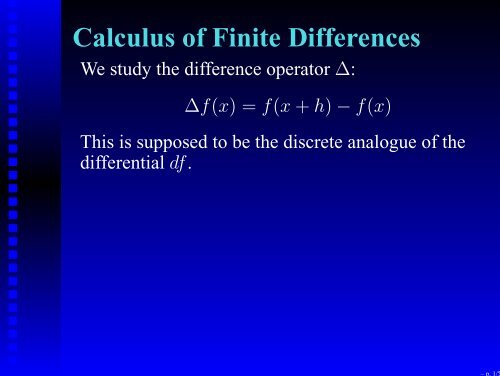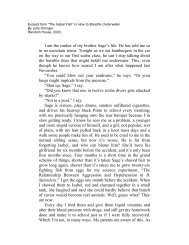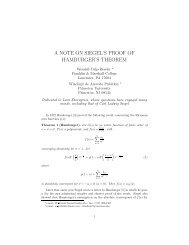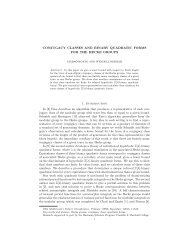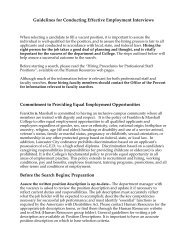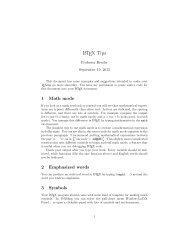Calculus of Finite Differences - eDisk
Calculus of Finite Differences - eDisk
Calculus of Finite Differences - eDisk
- No tags were found...
Create successful ePaper yourself
Turn your PDF publications into a flip-book with our unique Google optimized e-Paper software.
– p. 1/?<strong>Calculus</strong> <strong>of</strong> <strong>Finite</strong> <strong>Differences</strong>We study the difference operator ∆:∆f(x) = f(x + h) − f(x)This is supposed to be the discrete analogue <strong>of</strong> thedifferential df.
– p. 1/?<strong>Calculus</strong> <strong>of</strong> <strong>Finite</strong> <strong>Differences</strong>We study the difference operator ∆:∆f(x) = f(x + h) − f(x)This is supposed to be the discrete analogue <strong>of</strong> thedifferential df.I learned the topic from Samuel Goldberg at Oberlin.He wrote the book Introduction to DifferenceEquations, with illustrative examples from economics,psychology, and sociology.
– p. 2/?There are many similarities between ∆ and the usualcalculus operator d.The similarities are more striking if we set h = 1, andif we definex (n) = x(x − 1)(x − 2) · · · (x − n + 1);the x (n) s form a more natural basis for the space <strong>of</strong>polynomials when working with ∆.
– p. 3/?ThenThis should look familiar.∆x (n) = nx (n−1) .There is also the indefinite summation operator ∆ −1 ,the inverse <strong>of</strong> ∆, similar to the indefinite integral.
– p. 3/?ThenThis should look familiar.∆x (n) = nx (n−1) .There is also the indefinite summation operator ∆ −1 ,the inverse <strong>of</strong> ∆, similar to the indefinite integral.We have∆ −1 x (n) = x(n+1)n + 1 + C,where C is a constant (provided we work in C[x].)
The calculus <strong>of</strong> finite differences stayed with me,although I did not see any more <strong>of</strong> it.– p. 4/?
– p. 4/?The calculus <strong>of</strong> finite differences stayed with me,although I did not see any more <strong>of</strong> it.There were occasional encounters with this calculus,mainly in the context <strong>of</strong> difference equations (innumber theory or combinatorics).
– p. 4/?The calculus <strong>of</strong> finite differences stayed with me,although I did not see any more <strong>of</strong> it.There were occasional encounters with this calculus,mainly in the context <strong>of</strong> difference equations (innumber theory or combinatorics).But I did not encounter it in my work. I never had todiscrete-integrate a polynomial, and I never saw thecalculus <strong>of</strong> finite differences “in the wild”.
Twenty years later. . .– p. 5/?
– p. 6/?Down-up AlgebrasDown-up algebras were introduced by Benkart andRoby (1998); generalized by Cassidy and Shelton(2004).They encompass many previously studied algebras:• The enveloping algebra <strong>of</strong> sl(2);
– p. 6/?Down-up AlgebrasDown-up algebras were introduced by Benkart andRoby (1998); generalized by Cassidy and Shelton(2004).They encompass many previously studied algebras:• The enveloping algebra <strong>of</strong> sl(2);• S. P. Smith’s “algebras similar to U(sl(2))”;
– p. 6/?Down-up AlgebrasDown-up algebras were introduced by Benkart andRoby (1998); generalized by Cassidy and Shelton(2004).They encompass many previously studied algebras:• The enveloping algebra <strong>of</strong> sl(2);• S. P. Smith’s “algebras similar to U(sl(2))”;• Witten’s deformation <strong>of</strong> U(sl(2));
– p. 6/?Down-up AlgebrasDown-up algebras were introduced by Benkart andRoby (1998); generalized by Cassidy and Shelton(2004).They encompass many previously studied algebras:• The enveloping algebra <strong>of</strong> sl(2);• S. P. Smith’s “algebras similar to U(sl(2))”;• Witten’s deformation <strong>of</strong> U(sl(2));• Conformal sl(2) enveloping algebras;
– p. 6/?Down-up AlgebrasDown-up algebras were introduced by Benkart andRoby (1998); generalized by Cassidy and Shelton(2004).They encompass many previously studied algebras:• The enveloping algebra <strong>of</strong> sl(2);• S. P. Smith’s “algebras similar to U(sl(2))”;• Witten’s deformation <strong>of</strong> U(sl(2));• Conformal sl(2) enveloping algebras;• The enveloping algebra <strong>of</strong> the Heisenbergalgebra;
– p. 6/?Down-up AlgebrasDown-up algebras were introduced by Benkart andRoby (1998); generalized by Cassidy and Shelton(2004).They encompass many previously studied algebras:• The enveloping algebra <strong>of</strong> sl(2);• S. P. Smith’s “algebras similar to U(sl(2))”;• Witten’s deformation <strong>of</strong> U(sl(2));• Conformal sl(2) enveloping algebras;• The enveloping algebra <strong>of</strong> the Heisenbergalgebra;
– p. 7/?Definition <strong>of</strong> down-up algebrasUnfortunately these algebras are defined by generatorsand relations. We use C as our ground field. Fix apolynomial f ∈ C[x] and scalars r,s,γ ∈ C. Thedown-up algebra L = L(f,r,s,γ) is generated byelements d, u, and h, subject to the relations:hu − ruh = γudh − rhd = γddu − sud = f(h).Think <strong>of</strong> d as a down operator, u as an up operator,and h as a horizontal or sideways operator.
– p. 8/?Research aim: determine the primitive ideals <strong>of</strong> thesealgebras.Recall: a primitive ideal <strong>of</strong> an algebra A is theannihilator <strong>of</strong> an irreducible A-module.Primitive ideals provide a glimpse (<strong>of</strong>ten a revealingone!) <strong>of</strong> the representation theory <strong>of</strong> the algebra A.
Side remark: the theory <strong>of</strong> primitive ideals inenveloping algebras <strong>of</strong> semisimple Lie algebras is abeautiful and fascinating topic, touching uponharmonic polynomials, the combinatorics <strong>of</strong> Youngtableaux, and other neat stuff. But you don’t see theseesoteric material in low dimensions—<strong>of</strong>ten bruteforce calculations will suffice.– p. 9/?
– p. 9/?Side remark: the theory <strong>of</strong> primitive ideals inenveloping algebras <strong>of</strong> semisimple Lie algebras is abeautiful and fascinating topic, touching uponharmonic polynomials, the combinatorics <strong>of</strong> Youngtableaux, and other neat stuff. But you don’t see theseesoteric material in low dimensions—<strong>of</strong>ten bruteforce calculations will suffice.Down-up algebras have low dimensions, so there ishope that I can actually calculate their primitiveideals.
– p. 9/?Side remark: the theory <strong>of</strong> primitive ideals inenveloping algebras <strong>of</strong> semisimple Lie algebras is abeautiful and fascinating topic, touching uponharmonic polynomials, the combinatorics <strong>of</strong> Youngtableaux, and other neat stuff. But you don’t see theseesoteric material in low dimensions—<strong>of</strong>ten bruteforce calculations will suffice.Down-up algebras have low dimensions, so there ishope that I can actually calculate their primitiveideals.(And students can do some <strong>of</strong> the work too.)
– p. 10/?Let’s take the case r = s = 1 and γ ≠ 0. The definingrelations becomehu − uh = γu;dh − hd = γd;du − ud = f(h).This is very close to the relations defining U(sl(2)).
– p. 11/?Verma modulesLet λ ∈ C. The Verma module V (λ) has basis {v i } i≥0whereuv i = v i+1 , dv 0 = 0, hv 0 = λv 0 ;other relations are derived from the defining relations.Thus, for i ≥ 0,hv i = (λ + iγ)v i ,dv i+1 = [f(λ) + f(λ + γ) + · · · + f(λ + iγ)]v i .(You can see why u is the “up” operator, d is the“down” operator, and h is the “horizontal” operator.)
Annihilators <strong>of</strong> simple Verma modules provide uswith a large portion <strong>of</strong> all primitive ideals.– p. 11/?Verma modulesLet λ ∈ C. The Verma module V (λ) has basis {v i } i≥0whereuv i = v i+1 , dv 0 = 0, hv 0 = λv 0 ;other relations are derived from the defining relations.Thus, for i ≥ 0,hv i = (λ + iγ)v i ,dv i+1 = [f(λ) + f(λ + γ) + · · · + f(λ + iγ)]v i .(You can see why u is the “up” operator, d is the“down” operator, and h is the “horizontal” operator.)
First step: find a central element <strong>of</strong> the formud − p(h), where p(x) ∈ C[x].– p. 12/?
– p. 12/?First step: find a central element <strong>of</strong> the formud − p(h), where p(x) ∈ C[x].The center <strong>of</strong> the algebra plays an important role,because <strong>of</strong> the following result.Lemma. Let a be an element in the center <strong>of</strong> L, andlet M be an irreducible L-module. Then a acts as ascalar on M.
– p. 12/?First step: find a central element <strong>of</strong> the formud − p(h), where p(x) ∈ C[x].The center <strong>of</strong> the algebra plays an important role,because <strong>of</strong> the following result.Lemma. Let a be an element in the center <strong>of</strong> L, andlet M be an irreducible L-module. Then a acts as ascalar on M.This is a version <strong>of</strong> Schur’s Lemma, and in this case itis true because C is an uncountable algebraicallyclosed field.
– p. 13/?Say ud − p(h) commutes with u. Then[ud − p(h)]u= u(ud + f(h)) − p(h)u= u[ud − p(h)] + up(h) + uf(h) − p(h)u= u[ud − p(h)] + u[p(h) + f(h) − p(h + γ)].
– p. 14/?Thus ud − p(h) commutes with u if and only ifp(h) + f(h) − p(h + γ) = 0, i.e.,p(h + γ) − p(h) = f(h).This should look familiar!
– p. 15/?The polynomial p is more useful than the polynomialf. For example, the Verma module formuladv i = [p(λ + iγ) − p(λ)]v i−1 , i > 0,is easier to work with thandv i+1 = [f(λ) + f(λ + γ) + · · · + f(λ + iγ)]v i .
– p. 15/?The polynomial p is more useful than the polynomialf. For example, the Verma module formuladv i = [p(λ + iγ) − p(λ)]v i−1 , i > 0,is easier to work with thandv i+1 = [f(λ) + f(λ + γ) + · · · + f(λ + iγ)]v i .Results are also more elegantly stated in terms <strong>of</strong> prather than f.Theorem. V (λ) and V (λ ′ ) have the same annihilatorif and only if p(λ) = p(λ ′ ).
– p. 16/?Here are results about the primitive ideals <strong>of</strong> ourdown-up algebra.Theorem. Suppose p(x) is not the constantpolynomial. Let λ ∈ C. Then the annihilator <strong>of</strong> V (λ)is a primitive ideal. All other primitive ideals areannihilators <strong>of</strong> finite-dimensional simple modules. Allfinite-dimensional simple modules are quotients <strong>of</strong>Verma modules.So the situation in this case is quite similar to the case<strong>of</strong> enveloping algebras <strong>of</strong> semisimple Lie algebras.
– p. 17/?The special case where p(x) is constant is most easilydescribed by an explicit list.Theorem. Suppose p(x) is the constant polynomial.The primitive ideals in this case are 〈u〉, 〈d〉,〈u,d,h−λ〉, where λ ∈ C, and 〈ud −c〉, where c ≠ 0.


